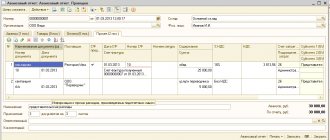Account 25 in accounting
Like all expense accounts, it is active and has no balance at the end of the reporting period. Expenses on account 25 are indirect, that is, it takes into account costs the cost of which cannot be directly attributed to specific types of products.
The list of expenses collected on account 25 contains the following expenses:
- employee salaries;
- administrative expenses;
- business trips;
- insurance premiums;
- maintenance of production equipment;
- maintenance and repair of buildings, production systems;
- maintenance of production facilities;
- production losses, etc.
Analytical accounting of overhead costs is broken down by department and cost item.
The account may not be used if the organization has a limited number of items produced. In this case, it is sufficient to use accounts 20 and 23. But for many organizations, the use of indirect costs is more profitable from the point of view of calculating profit.
To calculate the profit, direct and indirect costs are taken. Indirect expenses, including account 25, are written off completely, which reduces income tax.
Amounts on account 25 do not participate in the formation of cost; they are written off to accounts 20, 23 and 29. The write-off methodology and distribution procedure are fixed by the enterprise in its accounting policies.
Subaccounts
Sub-accounts can be opened to the “General production expenses” account:
- 25.01 — “Maintenance and operation of equipment”;
- 25.02 — “General shop expenses.”
In this case, the first subaccount takes into account and monitors the implementation of the cost estimate for maintaining and ensuring the operability of the equipment. For construction organizations, this equipment is construction machines and other mechanisms.
General production (general shop) expenses include the costs of management and maintenance of structural units of the main and auxiliary production.
Cost Allocation
Costs of account 25 are distributed to accounts 20, 23 and 29 by type of product in proportion to the established base. The distribution base for indirect costs is determined in accordance with methodological recommendations developed for various industries.
The choice of distribution methodology from an accounting perspective is selected depending on the reporting purposes. The least labor-intensive method is most often used - the distribution of indirect costs by a common base.
Typical postings for account 25
Procedure for distribution of indirect costs
The procedure for including general production and general business expenses in the cost price is determined by the accounting policy of the organization. In the configuration, “Accounting policy” processing is intended for these purposes (menu “Service” - “Accounting policy” - tab “Distribution of indirect expenses”).
To write off general business expenses based on the results of the month to the debit of account 90 “Sales” (subaccount 90.8 “Management expenses”), you must set the flag “Use the direct costing method”. Otherwise, general business expenses will, like general production expenses, be written off as a debit to account 20 “Main production”.
General production and general business expenses are written off to the debit of account 20 “Main production” with simultaneous distribution in accordance with the analytics of account 20:
- Types of nomenclature;
- Divisions.
The “Production Cost Items” analytics for account 20 does not participate in the distribution. In the generated transaction Debit 20 Credit 25 (26) the cost item “General production (general business) expenses” is indicated.
To write off general production and general business expenses to the debit of account 20, the distribution base is pre-calculated. The distribution base is calculated as the sum of costs (debit turnover on account 20 for the month being closed) for the items of production costs specified on the “Distribution of indirect costs” tab of the “Accounting Policy” processing. These may be items that reflect the wages of production workers, material costs, and/or others. Cost items included in the distribution base are marked with red checkmarks in the list form of the directory “Production Cost Items”.
The property of the cost item “Included in the distribution base of indirect costs” is periodic. This means that for different periods of the enterprise’s activity, the accountant himself determines the composition of these items.
For the purpose of distributing general production expenses, the distribution base is calculated for each division. General production costs of the division are distributed by type of item in proportion to the distribution base.
For the purposes of distributing general business expenses, the distribution base is calculated as a whole for account 20. General business expenses are distributed by type of item and divisions of the main production in proportion to the distribution base.
This difference in the distribution when writing off general production and general business expenses is associated with the interpretation of analytical accounting in the context of divisions in accounts 25 and 26:
- Analytical accounting of general production expenses on account 25 by division is carried out by structural divisions involved in the main production, which corresponds in purpose to analytical accounting by division on account 20;
- Analytical accounting of general business expenses for account 26 by division is carried out by structural divisions corresponding to the place where costs arise and, in general, not related to the main production.
Example
Initial data
The production cost item “Payment of production workers” is indicated as the distribution base. In accordance with the enterprise's accounting policy, the direct costing method is not used.
During the month, the following expenses are reflected in the accounting records:
- for account 20 “Main production” (see table 1):
Table 1
- for account 25 “General production expenses” (see table 2):
table 2
- for account 26 “General business expenses” (see table 3)
Table 3
Postings to account 25 “General production expenses”
Example 1
In July 2021 the following expenses were incurred:
- salary of the management staff - 315,000 rubles;
- contributions to extra-budgetary funds - 94,500 rubles;
- utilities - 98,000 rubles;
- depreciation of the industrial building - 31,000 rubles.
The accountant reflects these transactions with postings:
| Dt | CT | Operation description | Amount, rub. | Document |
| 25 | 70 | Salary reflection | 315 000 | Accounting information |
| 25 | 69 | Insurance premiums | 94 500 | Accounting information |
| 25 | 60 | Receipt of invoice for services | 98 000 | Invoice, invoice |
| 25 | 02 | Reflection of building depreciation | 31 000 | Accounting information |
| 20 | 25 | Write-off of general production expenses (sum of all expenses on account 25) | 538 000 | Accounting information |
Example 2
Let's consider an example of the distribution of costs of account 25 between workshops.
In 3 production workshops. The costs of each workshop are directly allocated to specific types of products or distributed among other types of products in proportion to individual types of expenses.
Let’s assume that the enterprise “KapStroyProekt” incurred general production costs for a certain reporting period:
- for the maintenance of buildings for general industrial purposes - 180,000 rubles;
- for labor protection - 90,000 rubles;
- for the salaries of shop managers - 310,000 rubles;
- for awards to “excellent production workers” - 120,000 rubles.
The total amount of these costs is distributed among the three workshops in accordance with the direct costs in each workshop. Employees' salaries:
- workshop No. 1 - 220,000 rubles;
- workshop No. 2 - 400,000 rubles;
- workshop No. 3 - 105,000 rubles.
Direct costs by workshop:
- workshop No. 1 - 60,000 rubles;
- workshop No. 2 - 80,000 rubles;
- workshop No. 3 - 40,000 rubles.
In accordance with the accounting policy of the organization, shop expenses are distributed between shops in proportion to the costs incurred:
- For the period under review, the total amount of shop expenses was: 180,000 + 90,000 + 310,000 + 120,000 = 700,000 rubles;
- Costs for all workshops were: 220,000 + 400,000 + 105,000 + 60,000 + 80,000 + 40,000 = 905,000 rubles.
We calculate the distribution coefficient:
- Shop No. 1: (220,000 + 60,000)/905,000* 100 = 31%
- Shop No. 2: (400,000 + 80,000)/905,000 * 100 = 53%
- Shop No. 3: (105,000 + 40,000)/905,000 * 100 = 16%
We calculate the distribution of overhead costs between workshops:
- Workshop No. 1: 700,000 * 31% = 217,000 rubles;
- Workshop No. 2: 700,000 * 53% = 371,000 rubles;
- Workshop No. 3: 700,000 * 16% = 112,000 rubles.
Closing the 25th account will be reflected by the following transactions:
| Dt | CT | Operation description | Sum | Document |
| 20.1 | 25 | Attribution of costs to 1 workshop | 217 000 | Accounting information |
| 20.2 | 25 | Attribution of costs to workshop 2 | 371 000 | Accounting information |
| 20.3 | 25 | Attribution of costs to workshop 3 | 112 000 | Accounting information |
Collection and distribution accounts
Collection and distribution accounts are intended for the collection and subsequent distribution of costs at individual stages of production and sale of finished products.
The following active accounts are classified as collection and distribution accounts:
25 “General production expenses”; 26 “General business expenses”; 44 “Sales expenses”.
The structure of accounts 25 and 26 has some features that distinguish them from other active accounts. These accounts do not have a balance because they are closed at the end of each month. In this regard, accounts 25 and 26 are not reflected in the balance sheet.
Chart of accounts 25 “General production expenses” and 26 “General business expenses”
| Debit | Credit |
| Have no balance | |
| Turnover by debit - costs associated with the maintenance and management of main production are reflected | Loan turnover - at the end of the reporting period, the amount of all costs is written off to the cost of production in the debit of account 20 “Main production” |
Account 25 “General production expenses” records general production costs that are associated with servicing the main production, for example, workshop costs for the maintenance and operation of equipment, salaries for equipment adjusters, depreciation and repair of fixed assets for general production purposes, etc.
d.
Account 26 “General business expenses” records general business expenses associated with enterprise management, i.e. maintenance of administration, accounting, office, payment for various legal, information, auditing services, etc.
These expenses are collected during the month on the debit of accounts 25 and 26, and at the end of the month they are ultimately written off to account 20, i.e., included in the cost of production. Expenses on accounts 25 and 26 are called indirect, since they are not directly related to the production of specific products.
Account 44 “Sales expenses” reflects the costs associated with the sale of products. Such expenses include the costs of containers, packaging, transportation, advertising of finished products, etc.
Example 4.7. Keeping records on collection and distribution accounts 25 and 26.
During the month, indirect expenses are reflected, shown in table. 4.5.
Necessary system settings for correct cost distribution
First of all, we note that for users to work correctly in the program, “Setting up accounting parameters” must be performed. For a manufacturing enterprise, on the “Types of Activities” tab, it is necessary to set the flag “Production of products, performance of work, provision of services” (Fig. 1).
Fig.1
The main settings that affect the closing of the month are made in the “Accounting Policies of the Organization”. It is recommended to set an accounting policy for each year, since some of the settings made in the accounting policy are periodic (for example, the list of direct tax accounting expenses is valid only during the year for which the accounting policy is set, and if the organization has introduced one accounting policy for 2 years, then in the second year all costs when closing the month in tax accounting will be classified as indirect). What tabs of the “Accounting Policy” affect the closing of the month in accounting?
- General information
- Production
- WIP
The flag “Production of products, performance of work, provision of services” in the accounting parameters settings is a common setting for all organizations for which accounting is maintained in the program. In the accounting policy on the “General Information” tab for each organization, it is necessary to duplicate this setting in order to show the program that this information is applicable for a specific organization (Fig. 2).
Fig.2
After setting this flag, the “Production”, “Product Output”, “WIP” tabs automatically appear.
On the “ Production ” tab, the parameters for the distribution of accounts 20, 23, 25, 26 are set (Fig. 3).
Fig.3
The distribution of costs in account 20 is made according to sales revenue. In our example, the collection of costs on account 20 is carried out in the context of two item groups - “Semi-finished products” and “Finished products”. Revenue from sales for both types of activities is also collected by product groups.
Depending on what setting is set for account 20 in the organization’s accounting policy, the program will determine whether account 20 should be closed for a specific analytics. What is important for the program is not the fact of collecting revenue for a specific item group, but how the revenue was collected (by what document).
- When the “At planned prices” flag is set, when closing the month, the revenue collected on account 90.01 by the document “Act on the provision of production services” will serve as the basis for the distribution of costs.
- When the “By revenue” flag is set, when closing the month, the revenue collected in account 90.01 by the document “Sales of goods and services” will serve as the basis for the distribution of costs.
- When the “At planned prices and output volume” flag is set, when closing the month, the revenue collected in account 90.01 by any of the documents will serve as the basis for cost distribution.
If an organization produces products, then costs are allocated to the products produced.
For organizations that provide services, the program analyzes not the collection of costs for a specific type of document, but the entries in the accumulation registers that produce these documents:
- at planned prices - the register “Output of products and services at planned prices”, formed by the document “Act on the provision of production services”
- by revenue - the "Sales of services" register, formed by the document "Sales of goods and services"
The distribution of costs 23 accounts is made according to the volume of output (in this case, to calculate the distribution base, the accumulation register “Output of products and services at planned prices” is analyzed). If account 23 reflects transactions for the provision of internal services between departments, then at the end of the month for each department 23 of account for which the collection of costs was reflected, it is necessary to enter the document “Production Report for the Shift”, which indicates the direction of distribution.
Note that the settings made in the organization’s accounting policy determine which indicator will be filled in in the document - planned prices or output volume. The “By planned prices and output volume” option allows the user to independently determine in the document which of the two indicators he wants to indicate.
IMPORTANT! The item group account 23 must differ from the item groups for which sales revenue is collected.
Account 23 is the only cost account for which you can specify the direction of distribution. According to the indicated direction, the regulatory operation “Closing accounts 20, 23, 25, 26” will work.
The distribution of costs of account 26 can be done in two ways:
- using the “direct costing” method: at the end of the month, entry Dt 90.08 Kt 26 will be generated and the collected costs will be included in management expenses
- not using the direct costing method: at the end of the month, general business expenses will be included in the cost of products produced or services provided, and the posting Dt 20 Kt 26 will be generated
When choosing the “direct costing” method, no additional settings for the distribution of costs 26 accounts are required.
When choosing the second option, the flag in the “direct costing” field is not set, and using the “Set methods for distributing general production and general business expenses” button, the base for distributing costs account 26 is set.
The distribution of costs for account 25 is made according to the base specified by the button “Set methods for distributing general production and general business expenses.”
In the information register “Methods for the distribution of general production and general business expenses” it is necessary to set the time period from which the distribution base, cost account and distribution base are valid (Fig. 4). Please note that in this register you can make detailed settings for each division and each cost item. If this information is not specified, the program will perceive it as a distribution method for all items of the specified cost account.
Fig.4
In the “Distribution base” field (Fig. 5), an indicator is indicated according to which on account 20 the costs of account 25 (and 26 if direct costing is not used) are distributed between item groups.
Fig.5
Please note that among the indicators there is an option “Individual direct cost items”. For this setting, the “List of cost items” field is intended, which indicates the list of cost items by which the indicator for calculating the base will be determined.
Account 44 is closed automatically, and the posting Dt 90.07 Kt 44.02 is generated. If in an organization, when collecting costs, a cost item with the type “Transportation costs” appears, then the distribution under this item is made in proportion to the balance of goods. The amount of direct expenses in terms of transportation costs related to the balance of unsold goods is determined by the average percentage for the current month, taking into account the carryover balance at the beginning of the month in the following order:
1. The amount of direct expenses attributable to the balance of unsold goods at the beginning of the month and incurred in the current month is determined;
2. The cost of purchasing goods sold in the current month and the cost of purchasing the balance of unsold goods at the end of the month are determined;
3. The average percentage is calculated as the ratio of the amount of direct expenses (clause 1 of this part) to the cost of goods (clause 2 of this part);
4. The amount of direct expenses related to the balance of unsold goods is determined as the product of the average percentage and the cost of the balance of goods at the end of the month” (Article 320, Chapter 25 of the Tax Code of the Russian Federation).
WIP tab indicates how the amount of work in progress is determined (Fig. 6). The user is given the opportunity to install one of two options:
- responsibility for determining the amount of work in progress falls on the shoulders of the accountant, who enters the document “Inventory of work in progress” and reflects in this document a list of item groups and the amount of costs that should remain in the work in progress.
- the amount of work in progress is determined by the program independently: costs for a product group for which there was no production are regarded as work in progress. At the same time, the accountant can also enter the document “Inventory of work in progress”, assigning an additional amount of costs to work in progress.
Fig.6
Collection and distribution accounts
Exercise. Determine the amount of write-off of general production and general business expenses for accounts 25 and 26 at the end of the month.
Table 4.5
| Contents of operation | Amount, rub. | Debit | Credit |
| 1 . Salary accrued: a) accounting workers b) equipment adjusters | 10000 15000 | 26 25 | 70 70 |
| 2. Social tax (35.6%) is charged on wages: a) accounting workers b) equipment adjusters | 3560 5340 | 26 25 | 69 69 |
| 3. Postal expenses for the office were paid from the cash register. | |||
| 4. Inventory written off to the HR department | |||
| 5. Spare parts written off for equipment repairs | |||
| 6. The invoice for legal services has been accepted and paid | |||
| 7. Depreciation of the freight elevator has been calculated | |||
| 8. The invoice for the installation of the alarm system has been accepted and paid. | |||
| 9. At the end of the month, overhead costs were written off as production costs. | ? | ||
| 10. At the end of the month, general business expenses are written off as production costs | ? |
To solve the problem, it is necessary to collect and close accounts 25 and 26.
| Account 25 “General production expenses” |
| Debit | Credit |
16) 15000 26) 5340 5) 1 000 7) 360  1 500 1 500 | 9) 23200 |
| Od = 23200 | Ok = 23200 |
The amount of general production costs for the month was 23,200 rubles, and the amount of general business expenses was 15,900 rubles.
At the end of the month, accounts 25 and 26 are closed. To do this, the amount of debit turnover in the same amount is written off from the credit of these accounts to the debit of account 20. Since the turnover on accounts 25 and 26 will be equal, these accounts will not have a balance.





